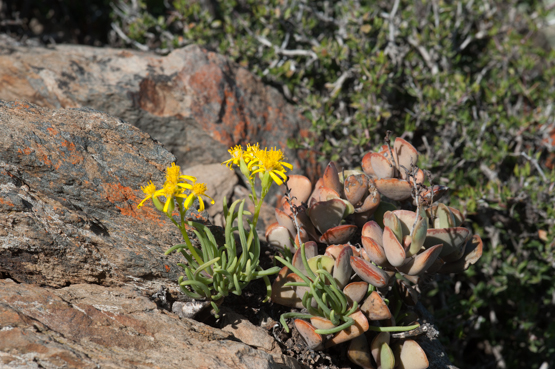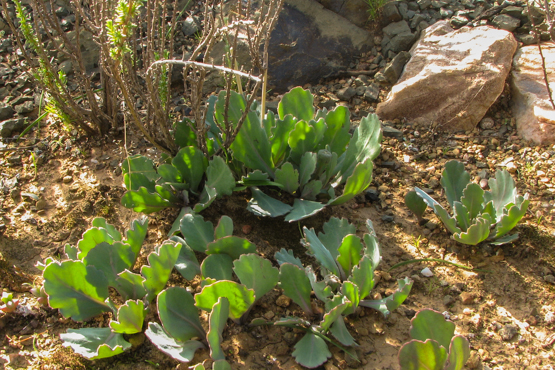The companion plant in the last picture is Adromischus triflorus

When the Swiss botanist Augustin de Candolle described this species in 1838, he apparently saw a likeness to a Cotyledon. But when I ran through the mental pictures of Cotyledons that I know, I wondered what resemblance he could have had in mind. So, some detective work was called for.
Did de Candolle compare his new species to a plant that at that moment was incorporated in Cotyledon, but now belongs in another genus? That is certainly a possibility, as no less than 471 plant names have been associated with the genus at some stage.
On the other hand, looking through “Cotyledon and Tylecodon” by Van Jaarsveld and Koutnik, it struck me that some narrow-leaved forms of C. orbiculata could well have been the inspiration for de Candolle’s name. Let’s not forget that he probably knew many plants from descriptions or at best from black and white drawings, rather than from live material. In the book I just mentioned, there are a few reproduction of old illustrations. One dates back to 1701 and represents Cotyledon africana frutescens, folio longo & angusto…. ( the shrubby Cotyledon from Africa, with long, narrow leaves), which is now known as C. orbiculata var. spuria. This picture may well have spurred (pun intended) the author to use his epithet.
Well, enough of historical speculation, let’s move to present-day reality.
S. cotyledonis is a shrub of up to 1 m tall, with thickish stems and succulent triangular to almost round leaves up to 5 cm long and about 3 mm wide. The leaves give off an unpleasant smell when damaged, which is why it is called stinkbos in Afrikaans.
The plants flower in spring. They are widespread from Namibia to the eastern part of the Little Karoo. Usually they are found on dry stony slopes, but sometimes they are abundant in clayey soils.
To be continued.
Polytomus means something like much divided and refers to the fact that the plants are much more branched than in otherwise similar species like S. scottii and S. odora.
In nature the plants form compact shrubs up to about a meter tall; in cultivation they may reach 3 m.
They are locally common in the Sanaag region of northern Somaliland in dry bush land on stony plains and slopes at altitudes between 1000 and 1900 m.
The flowers range in colour from white and yellow to pink, purple and magenta. They usually appear in October and November, but the accompanying pictures were made in late January.
When we think of succulent members of the enormous Asteraceae (Compositae) family, almost automatically the genus names Othonna and Senecio pop up. Some people will also be acquainted with synomym names like Kleinia, Curio or Notonia, but that is probably it.
Browsing through the Dicotyledons volume of The Illustrated Handbook of Succulent Plants will reveal quite a few more names of genera containing one or more succulent species. One of these is the subject of this post.
Didelta carnosa is the one succulent member of the genus and occurs in southern Namibia and the northern part of South Africa. When flowering it is quite a showy plant, with flower heads up to 9 cm across. In var. tomentosa the leaves -or at least the young ones- have a silvery white woolly cover. The plants grow near to the sea.
(The pictures were taken at McDougall’s Bay, where the plants are accompanied by Fenestraria rhopalophylla ss. aurantiaca, Crassula atropurpurea var. cultriformis and other interesting little succulents).
These plants may be up to 30 cm tall but are usually much lower.
The leaves are up to 10 cm long and cylindrical (in the dry season they become flattened). Apparently they are tasty to some animals, as one often sees them with the upper half chewed off.
The flowers appear in Oct. Nov. and are large and showy (up to over 2 cm in diameter).
The species occurs on rocky outcrops from the Ceres Karoo to the Kouga Mts.
Tuberous Othonnas are not very common in cultivation, mainly due I suppose because they are difficult to propagate. Taking cuttings is not really an option and seeds are hard to get and to germinate. It can hardly be caused by lack of appeal, as the following pictures will hopefully show you.
O. auriculifolia is quite widespread in nature, from the Bokkeveld Mountains to Uniondale on stony, clayey or sandy slopes and flats.
The flowerheads are about 2 cm across and appear from April to September. The ray florets are always bright yellow, but the central ones may also be a darker yellow or even a very dark, almost black, purple.

More pictures to follow.
In 1997 Senecio articulatus was placed in the genus Curio, together with a number of other succulent Senecios. As the changes were published in a not very well known journal, they have not been generally accepted (yet?).
Poor old S. articulatus must be in an identity crisis by now, because since it was named first, it has been placed in four different genera (Cacalia, Kleinia, Senecio and now Curio).
Maybe we should just stick to the beautifully descriptive Afrikaans name Worsies (sausages).
The species is widespread from Montagu to Uitenhage, on rocky slopes, usually in (partial) shade.